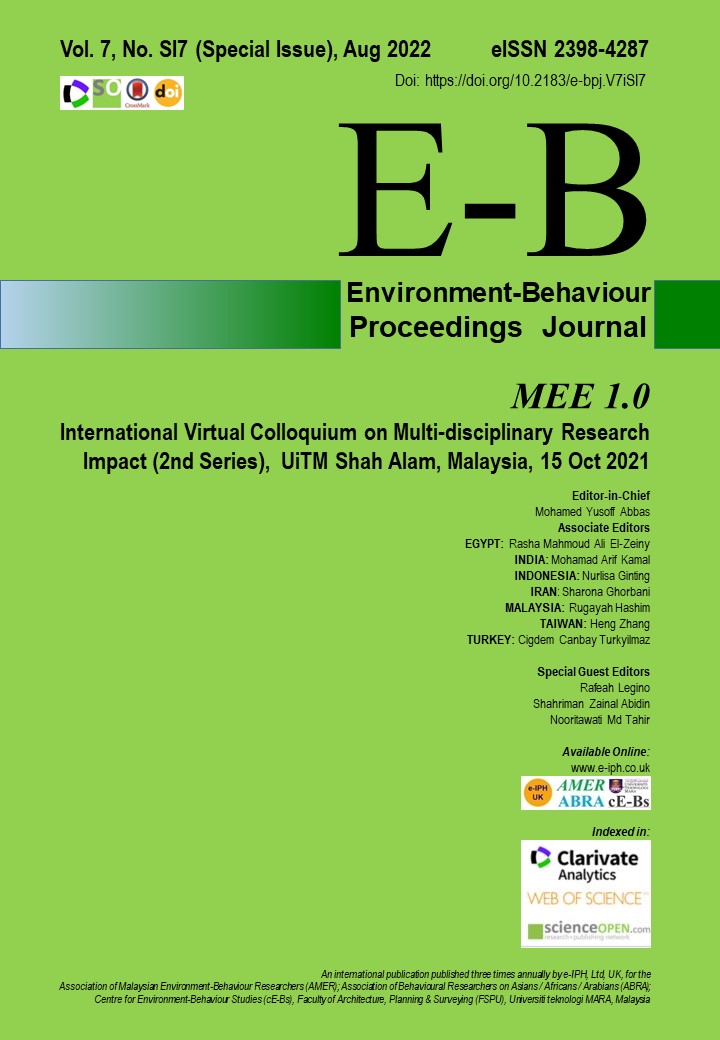Conceptualizing Touch Aesthetic Communication as a Model Pictorial Art Appreciation
DOI:
https://doi.org/10.21834/ebpj.v7iSI7.3780Keywords:
Art, Touch, Communication, Visual Art Experience, TactileAbstract
Haptic communication through pictorial art remains an argumentative subject of aesthetic experience, with many unresolved issues until today that questioning the how and why reactions of various people. Throughout this framework of research, a conceptual examination of experiencing a pictorial work of art (its duration, intensity, and individual art expression) for a congenitally blind person by applying Verbal Protocol Analysis (VPA) approach model was designed to enhance the experience from an artwork. This study provides an observation procedure within the influence of 'time of experience' and 'art expression' mediated by professional artwork.
References
Blessing, L. T., & Chakrabarti, A. (2009). DRM: A design research methodology (pp. 13-42). Springer London.
Blind Malaysian Muslims memorizing Quran using Braille, The Straits Times, June 8, 2017, https://www.straitstimes.com/asia/se-asia/blind-malaysian-muslims-memorising-quran-using-braille
Official Website of the Paralympic Movement, International Paralympic, https://www.paralympic.org/classification
Classen, C. (1998). The color of angels: Cosmology, gender, and the aesthetic imagination. Psychology Press.
Coates, C., (2019). Best practice in making Museums more accessible to visually impaired visitors. Museum Next. https://www.museumnext.com/article/making-museums-accessible-to-visually-impaired-visitors/
Crilly, N., Moultrie, J., & Clarkson, P. J. (2004). Seeing things: consumer response to the visual domain in product design. Design studies, 25(6), 547-577.
Davis, E. “Structures of Seeing: Blindness, Race, and Gender in Visual Culture.” The Senses and Society 14 (1): 63–80.
Diaconu, M. (2006). Reflections on aesthetics of touch, smell and taste. Contemporary aesthetics, 4(1), 8.
Green, A. (1998). Verbal protocol analysis in language testing research: A handbook (Vol. 5). Cambridge University Press.
Hayhoe, S. (2008). Arts, culture, and blindness: Studies of blind students in the visual arts. Cambria Press.
Jones, L. (2018). Haptics. MIT press.
Jones, L. A., & Sarter, N. B. (2008). Tactile displays: Guidance for their design and application. Human Factors, 50, 90–111.
Kaspin, S. (2021). Identifying Factors Leading To Gold Losses During The Fabrication Process And Assessing Its Impact On The SMEs Jewellery Industry. Turkish Journal of Computer and Mathematics Education (TURCOMAT), 12(7), 975-985.
Lahtinen, R., Palmer, R., & Ojala, S. (2012). Visual art experiences through touch using haptics. Procedia-Social and Behavioral Sciences, 45, 268-276.
Lahtinen, R., Groth, C., & Palmer, R. (2017, November). Haptic Art Experiences Described as Vocals, Sounds, and Written Words by Deafblind. In Proceedings of the Art of Research Conference, Helsinki, Finland (pp. 28-29).
Lauwrens, J. (2019). Touch as an aesthetic experience. Journal of Visual Art Practice, 18(4), 323-341.
Mohamad, N., Kaspin, S., & Noor, R. M. (2017). Malaysia design industry: Competition for Malaysia design businesses 2013. Advanced Science Letters, 23(1), 280-282.
Plattner, H., Meinel, C., & Leifer, L. (Eds.). (2012). Design thinking research. Berlin: Springer.
Sless, D. (198199). Learning and visual communication. Halsted Press.
Vermol, V. V., Anwar, R., Hassan, O. H., & Abidin, S. Z. (2015, September). Work in Progress: Mapping the development of quality sensuous response through Blind and Visually Impaired group (BVIG) touch interaction. In 2015 International Conference on Interactive Collaborative Learning (ICL) (pp. 25-29). IEEE.
Vermol V.V., Abidin S.Z., Anwar R., Hassan O.H. (2018) Blind User Experience Audit: Revealing Underlying Invisible Factors in Design Experience. In: Anwar R., Mahamood M., Md. Zain D., Abd Aziz M., Hassan O., Abidin S. (eds) Proceedings of the Art and Design International Conference (AnDIC 2016). Springer, Singapore. https://doi.org/10.1007/978-981-13-0487-3_55
Downloads
Published
How to Cite
Issue
Section
License
Copyright (c) 2022 Nadiah Mohamad, Verly Veto Vermol, Rusmadiah Anwar

This work is licensed under a Creative Commons Attribution-NonCommercial-NoDerivatives 4.0 International License.





